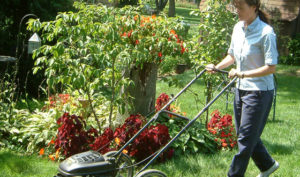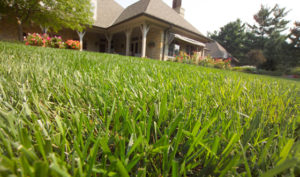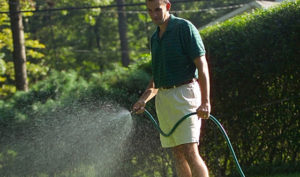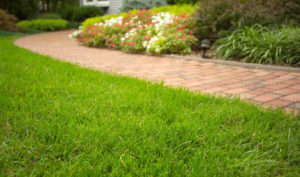
LANDSCAPING TIPS
As a member of The Estates Homeowner’s Association, we all pay to live in a well-kept community that we all must maintain to achieve a certain standard of beauty the community deserves. The weather here in Georgia is excellent for maintaining a lush environment, however, keeping the community beautiful is no easy task and is indeed a community effort. If you struggle with weeds, see the PRE-EMERGENT TIPS link at the bottom of the page. Here are a few landscaping tips we would like to share.

Mowing
Here are some answers to some common mowing questions that arise in the maintenance of your lawn. For example, a properly mowed lawn will grow thicker, have deeper root growth, and be more resistant to disease, insects, and seasonal stress. TruGreen ChemLawn has provided mowing tips to keep your lawn healthy.
- Mow regularly and remove only one-third of the growth at any one time.
- Mow the grass in a different direction each time. Grass tends to grow or lean in the direction it is mowed. Repeated mowing in the same direction can cause it to grow horizontally, creating microclimate conducive to diseases, insects, and excessive thatch.
- Mow in the early evening. This gives the grass blades time to recover from the cut before they are exposed to the daytime heat and wind.
- Mow with a sharp blade. Anytime grass is mowed it is injured. These injuries provide a place for fungi and other pathogens to enter and infect the plant. Also, a clean, sharp cut looks better than a ragged, torn cut caused by dull blades.
- Never mow wet grass.
- Mow using a mulching mower. The clippings are 90% water and will generally decompose in 7 to 10 days. Also, the clippings will add fertilizer back into the soil, saving you time and money. A healthy, well-maintained lawn does not develop thatch due to clippings.
- A healthy lawn requires healthy soil that supports it. Soil maintenance involves aeration, the proper pH balance, a steady source of new organic material and/or fertilizer. When the soil has sufficient air, water, minerals, and organic material, it can support the needs of the grass plant and help eliminate thatch through decomposition.

Practical Weed Control Tips
Here are some basic tips for controlling weeds in your yard:
- Use a separate sprayer for weed and insect control. It is not a good idea to apply an insect killer from a sprayer that’s had a weed killer in it.
- Keep sprayer adjusted to reduce fine spray and avoid windy days. Fine spray droplets can be carried a long distance in the wind.
- Just apply enough weed spray to coat the weed leaves. Drowning the leaves with spray only wastes the spray and is not economical.
- Watch the weather. Make sure that there will be at least 24 hours of good weather following the day you spray. This will ensure that the weed killer is absorbed into the leaf.
- Be patient. Some weed killers take longer to react to a plant’s system and some are designed to move through the whole plant before they begin to work. This takes time and it may be several days before you begin to see any signs of the weed killer at work.
- Young weeds are easier to kill than older ones.
- Weeds are easier to kill when they are actively growing. Weeds may be hard to kill on hot-dry days.
- Read the instructions provided by the manufacturer and apply the weed killer in the recommended amount. Anything less, you may not get the desired result you are seeking. Anything more and you are wasting your money and you may kill/burn desirable plants that you want to keep.
- Know the type of weed you are trying to exterminate. Know its life cycle. Some weeds are easier to kill with a pre-emergent and if applied at the correct moment, you can get the results you desire.
- Maintain a healthy lawn and proper mowing techniques. A good mowing program will tend to thicken the grass and reduce weed growth. However, some weeds will grow in any type of condition, therefore you may still need to dig them out or apply a chemical.

Watering
You should care about your lawn and its overall health. There are ways that you can be an active participant in keeping your lawn and landscape lush and green. Sufficient water is essential to growing and maintaining a lush, beautiful lawn. We have provided watering tips to keep your lawn healthy.
- Deep soaking encourages the development of a deep root system and makes your grass healthier.
- Inadequate watering can cause your grass to thin, lose color, and be more susceptible to insects and disease.
- The key is to get enough water into the soil to thoroughly soak the root zone.
- Most grasses require about one inch of water each week for healthy growth.
- Water in the morning if possible to conserve water and let the grass dry before evening.
- If excessive thatch is present, water slowly to allow for penetration and reduce runoff.
- Newly seeded areas should be watered at least daily to keep surface moist.

Maintaining Trees and Shrubs
Here are some common questions that arise in the maintenance of your lawn. You can keep your trees and shrubs growing and beautiful with these maintenance tips:
Watering
- Newly planted plants are highly susceptible to dry conditions because of the limited root system. Therefore, apply supplemental water and soak the entire root system with each watering.
- Water twice a week during the hot season unless there is an inch of rainfall every seven to ten days.
Mulching
- Cover the area around your trees or shrubs with one to four inches of mulch at one time during the fall.
- Professionals recommend using organic mulches like ground bark.
- Newly planted trees and large shrubs should have their trunks and larger branches wrapped to reduce sunscald.
- Remove wrapping the following spring and reapply in the fall.
Pruning
- Cut branches at different lengths to achieve the desired shape for deciduous trees and shrubs.
- Thin out the interior of the plant by removing dead branches and selectively remove branches or twigs to reduce overcrowding.
- Shaping and thinning can generally be done anytime, but pruning certain shrubs will reduce flowering the following spring.
- Evergreen pruning can be done on an annual basis and can be used to thicken the overall plant.
Fertilize
- Fall and spring are typically the best seasons for fertilization when root growth is most active.
- Apply fertilizer to the surface of the soil or inject it into the ground.
Fertilizer should be applied under the spread of tree branches, but not too close to the trunk.
DO-IT-YOURSELF TIPS
For all our Members who would prefer not to use a lawn care company to maintain your lawn, and would rather do-it-yourself, here is a great for a Georgia Lawn Calendar video with lots of tips and suggestions: